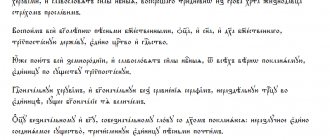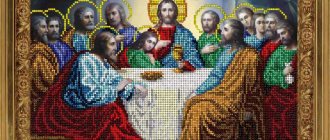Synodal translation of the Bible: how it happened
The Russian Bible, it seemed, had always been there. Its translation, known to us as the Synodal, is perceived as something unshakable and indisputable... but how much controversy its birth caused, how many obstacles there were in its path, how long this story lasted!
Attempts to translate the biblical text into Russian have been made for quite a long time: here one can recall the transcriptions of the psalms of Simeon of Polotsk (1680), Abraham Firsov (1683), Vasily Trediakovsky (1753), as well as the semi-mythical translation of Pastor Ernst Gluck, which disappeared without a trace after his death in 1705. Perhaps he never existed.
But the fundamental decision to prepare an official translation of the Bible into Russian was made by the Holy Synod at the suggestion of Emperor Alexander I only at the beginning of 1816. A major role here was played by the Russian Bible Society, established several years earlier on the model of some Western countries (the first such society was created in Great Britain). The goal of such societies from the very beginning was to provide everyone with the publication of the Bible at an affordable price and in their native language, and it is quite natural that in Russia this was, first of all, the Russian language.
Already in 1819, the Four Gospels were published, and in 1821, the complete New Testament. The first editions were parallel, with Russian and Slavic text. Work also began on the Old Testament, while initially the translation was made from the Hebrew text, and during editing, options from the Greek translation (Septuagint) were added in square brackets. In 1822, the Psalter was first published, and in two years its circulation amounted to more than one hundred thousand copies.
The main supporters of the translation at that time were the Chief Prosecutor and Minister of Education, Prince A. N. Golitsyn, as well as the rector of the St. Petersburg Theological Academy, Archimandrite Philaret (Drozdov), the future Metropolitan of Moscow and Kolomna, now known to us as St. Philaret. Golitsyn's resignation in 1824 largely determined the fate of the entire project: the Bible Society was closed, translation work was stopped, and at the end of 1825 the circulation of the first eight books of the Old Testament was burned in a brick factory. Critics, among whom should be named Metropolitan of Novgorod and St. Petersburg Seraphim (Glagolevsky) and the new Minister of Education Admiral A. S. Shishkov, were not so much dissatisfied with the quality of the translation as they denied the very possibility and necessity for Russian readers of any Bible other than the Church Slavonic . Of course, wariness about the mystical quests and religious experiments of the then St. Petersburg society also played a role.
For more than three decades, any official work on translation became impossible. However, the urgent need for it did not go away; the Church Slavonic text still could not satisfy everyone: suffice it to say that A. S. Pushkin read the Bible in French. Therefore, unofficial work on translations continued.
First of all, two people should be mentioned here. The first is Archpriest Gerasim Pavsky, who became the main editor of the first official translation back in 1819. Then he taught Hebrew at the St. Petersburg Theological Academy. In the classes, he widely used educational translations of some prophetic and poetic books of the Old Testament, where, among other things, excerpts from the prophetic books were arranged not in canonical, but in “chronological” order, in accordance with the ideas of some scientists of that time. The students found the translations so interesting that their lithographic copies began to be distributed outside the Academy and even St. Petersburg.
As a result, in 1841, a synodal investigation was conducted following a denunciation of the translator. O. Gerasim remained at the Academy, but had to forget about any translation activity for a long time. Subsequently, already during the preparation of the Synodal publication, in the magazine “The Spirit of a Christian” in 1862-1863. His translations of some historical books of the Old Testament and Proverbs were published. O. Gerasim was a consistent supporter of translation only from the Hebrew, the so-called Masoretic text, which in those days scholars usually identified with the original Bible.
Another translator of that time was the Monk Macarius (Glukharev), the enlightener of Altai. Living in the mission he founded in the Altai foothills, he not only translated Scripture into the language of local nomads (whose descendants today retain the warmest memory of him), but also thought about the need for a Russian translation of the Old Testament. The translation of the New Testament and Psalms already existed by that time, although it was no longer printed or distributed, so it is no coincidence that all translation activity at that time was aimed at filling the gap in the Old Testament part of Scripture. To begin with, Fr. Macarius wrote to Metropolitan Philaret about his proposals, but since there was no response, in 1837 he began independent work, partly using Pavsky’s lithographs. He first sent the results of his labors to the Commission of Theological Schools, and then directly to the Synod, with his letter attached.
The tone of his message to the Synod was consistent with the book of Isaiah, which it accompanied. Father Macarius denounces the Synod for its unwillingness to do good in the matter of spiritual enlightenment of Russia, calls the Decembrist revolt, the flood in St. Petersburg and other disasters a direct consequence of this negligence. He repeats the same words without hesitation in a letter to Emperor Nicholas I himself! The answer was a not too heavy penance... and draft translations handed over to the archives. However, Metropolitan Philaret, after this story, drew attention to Father Macarius and wrote him a detailed answer, the essence of which boiled down to one thesis: the time has not yet come for this translation.
However, Father Macarius continued his work and translated the entire Old Testament, except for the Psalter, which had long been published; his translations after his death were published in the Orthodox Review for 1860-1867. and were used in the preparation of the Synodal edition. These translations follow the Hebrew text exactly.
During the reign of Nicholas I, when practical translation work could only be of a private nature, Saint Philaret developed theoretical foundations for future translation. A special role was played by his note to the Holy Synod “On the dogmatic dignity and protective use of the Greek seventy interpreters and Slavic translations of the Holy Scriptures” (1845) - in fact, the methodological basis of the future Synodal translation.
As you can see, for most translators of that time the question of a textual basis for translating the Old Testament simply did not arise - they took the Hebrew text that has come down to us. At the same time, it was clear to everyone that the traditional text of the Orthodox Church has always been the translation of the seventy interpreters, or the Septuagint, from which the Church Slavonic translation was also made at one time. It cannot be said that other versions of the text were always rejected: for example, when preparing the first complete edition of the Bible in Rus', the so-called. “Gennadian Bible” of 1499, both the Latin translation and partly even the Hebrew Masoretic text were used. Still, the Masoretic Text traditionally belonged to the synagogue rather than to the Church.
Metropolitan Philaret proposed a kind of compromise: to translate the Hebrew text, but to supplement and even edit the translation in accordance with the Septuagint and the Church Slavonic text. This is exactly what it was decided to do when, at the meeting of the Synod on the occasion of the coronation of Alexander II (1856), at the suggestion of the Metropolitan, it was decided to resume the translation of the Bible into Russian. However, this decision did not mean the start of work, because the project had many opponents. These included, for example, Metropolitan of Kiev Filaret (Amphitheaters). The argumentation of opponents of the translation has remained virtually unchanged since the time of Admiral Shishkov: Church Slavonic and Russian are different styles of the same language, moreover, the first unites different Orthodox peoples. “If you translate it into Russian, then why not translate it into Little Russian, Belarusian, etc.!” - Metropolitan Philaret of Kiev exclaimed. In addition, wide familiarity with the biblical text could, in his opinion, contribute to the development of heresies, as happened in the homeland of biblical societies, in England. Instead of translation, it was proposed to correct individual words of the Slavic text and teach the people the Church Slavonic language. By the way, the same solution was proposed for “foreigners”, in relation to whom it looked completely utopian. Chief Prosecutor Count A.P. Tolstoy shared this position.
The dispute between the two Metropolitan Philaretov, Moscow and Kyiv, became the subject of detailed discussion in the Synod, and in 1858 it confirmed the decision of two years ago: to begin translation. The emperor approved this decision. As a result, four Theological Academies (St. Petersburg, Moscow, Kyiv and Kazan), which were entrusted with this endeavor, created their own translation committees. Their works were approved by the diocesan bishops and then by the Synod, which completely devoted one of its three present days to this work. Then Saint Philaret of Moscow contributed his editing, who was actually the editor-in-chief of this translation and devoted the last years of his life to working on it (he died in 1867). Finally, the text was finally approved by the Synod.
Thus, the Four Gospels were published in 1860, and the New Testament in 1862. Of course, this was a new translation, significantly different from the editions of the early 19th century. In preparation for the publication of the Old Testament, existing translations of Fr. Macarius, which were seriously edited, and newly prepared texts. From 1868 to 1875, separate collections of Old Testament books were published.
Work on them was carried out in accordance with the principles of the “Notes” of St. Philaret: the Hebrew text was taken as a basis, but additions were given to it and corrections were made based on the Greek and Slavic texts. The most obvious of these additions were placed in simple brackets, which created confusion: the brackets were also used as a regular punctuation mark. As a result, a special type of text emerged, eclectically combining elements of Hebrew and Greek text. As for the New Testament, everything was much simpler: the traditional Byzantine version of the text, with minor differences, was known both in the West (the so-called “Textus receptus”, “generally accepted text”) and in the East of the Christian world. Its Western editions were taken as a basis, and words that were present in Church Slavonic, but absent in these editions, were also given in parentheses. The words added “for clarity and connection of speech” have been italicized.
So, in 1876, the complete Bible was finally published, which henceforth received the name Synodal. However, her story did not end there... but this is a subject for another conversation.
Search by creativity and criticismThe word "SINODALA"
0-9Variants of the word: SINODAL, SINODALU, SINODALE
1. Andronikov I. L.: Lermontov. Research and findings. Lermontov in Georgia. Clause 16
Inclusion: 6. Size: 17kb.
2. Semenov L.P.: Lermontov and folklore of the Caucasus. VI. Folklore of the peoples of Transcaucasia in Lermontov's poetry
Inclusion: 5. Size: 70kb.
3. Popov A.V.: Lermontov in the Caucasus. In the first link. In Kakheti
Inclusion: 5. Size: 16kb.
4. Lermontov Encyclopedia. Articles starting with the letter “C” (part 2, “SKA” - “SOS”)
Inclusion: 3. Size: 56kb.
5. Rosenfeld B. M.: “To be modest, he’s a genius...”
Inclusion: 3. Size: 25kb.
6. Shan-Girey. M. Yu. Lermontov.
Inclusion: 2. Size: 73kb.
7. Bondarenko V.G.: Lermontov - Mystical genius. "Sad demon, spirit of exile..."
Inclusion: 2. Size: 45kb.
8. Miller O.V.: According to Lermontov’s places. Andronikov I.L.: Lermontov’s routes
Inclusion: 2. Size: 15kb.
9. Literary types of Lermontov (edited by N. Noskov) - old spelling. Letter C
Inclusion: 2. Size: 26kb.
10. Semenov L.P.: Lermontov and Leo Tolstoy. 1. Lermontov and Leo Tolstoy. Chapter XXVII. A few words about the subjectivity of the works of Lermontov and Tolstoy and their artistic techniques
Inclusion: 2. Size: 19kb.
11. Danilova N. Yu.: Lermontov and music
Inclusion: 2. Size: 49kb.
12. Semenov L.P.: Lermontov in the Caucasus. VI. Caucasian motifs in the works of M. Yu. Lermontov in 1840 and 1841.
Inclusion: 2. Size: 54kb.
13. Khodanen L.A. — Poems by M. Yu. Lermontov (Poetics and folk-classical traditions: Textbook). Chapter 3
Inclusion: 2. Size: 46kb.
14. Gireev D.A.: Poem by M. Yu. Lermontov “Demon”. Applications
Inclusion: 1. Size: 45kb.
15. Lermontov Encyclopedia. ZICHI MIKHAIL (MIKHAI) ALEXANDROVICH
Inclusion: 1. Size: 7kb.
16. Lermontov M.Yu. Encyclopedic Dictionary. Perception of Lermontov's creativity. Shalyapin Fedor Ivanovich
Inclusion: 1. Size: 4kb.
17. Semenov L.P.: Lermontov and Leo Tolstoy. 1. Lermontov and Leo Tolstoy. Chapter XVI. Heroes of Lermontov and Tolstoy (continued). Love of horses and fast riding
Inclusion: 1. Size: 22kb.
18. Andronikov I. L.: Lermontov. Research and findings. Lermontov in Georgia. Point 4
Inclusion: 1. Size: 9kb.
19. Lermontov: Pictures. Watercolors. Drawings (Kovalevskaya E.A., Andronikov I.L., Zhelvakova I.A.). Andronikov I. L.: Introductory article
Inclusion: 1. Size: 43kb.
20. Afanasyev V.V.: Lermontov. Part six. Chapter 5
Inclusion: 1. Size: 63kb.
21. Lermontov Encyclopedia. Articles starting with the letter “K” (part 4, “KOG” - “K”)
Inclusion: 1. Size: 50kb.
22. Semenov L.P.: Lermontov and Leo Tolstoy. 1. Lermontov and Leo Tolstoy. Chapter XXVI. Angel of Death
Inclusion: 1. Size: 32kb.
23. Gireev D.A.: Poem by M. Yu. Lermontov “Demon”. Chapter I. Creative history of the poem. 3. Caucasian editions of the poem
Inclusion: 1. Size: 35kb.
24. Kovalevskaya E.A. — The first theatrical interpretation of Lermontov’s poem “The Demon”
Inclusion: 1. Size: 40kb.
25. Lermontov Encyclopedia. Articles starting with the letter “R” (part 2, “ROZ” - “SNOUT”)
Inclusion: 1. Size: 51kb.
26. Lermontov Encyclopedia. Articles starting with the letter "SH"
Inclusion: 1. Size: 62kb.
27. Andronikov I. L.: Lermontov. Research and findings. Lermontov in Georgia. Point 5
Inclusion: 1. Size: 7kb.
28. Durylin S.: Vrubel and Lermontov. Chapter III
Inclusion: 1. Size: 33kb.
29. Literary types of Lermontov (edited by N. Noskov) - old spelling. Daemon
Inclusion: 1. Size: 27kb.
30. Demon, edition 8 September. 1838 (Edition 6)
Inclusion: 1. Size: 33kb.
31. Demon, final edition
Inclusion: 1. Size: 47kb.
32. Literary types of Lermontov (edited by N. Noskov) - old spelling. List of works by M. Yu. Lermontov and the types, images, faces and names included in them
Inclusion: 1. Size: 33kb.
33. Fedoseenko N. G.: M. Yu. Lermontov and the theater of the 21st century
Inclusion: 1. Size: 40kb.
34. Literary types of Lermontov (edited by N. Noskov) - old spelling. Letter K
Inclusion: 1. Size: 19kb.
35. Dzhaubaeva F.I.: Language creativity of Russian writers in the North Caucasus. Lexical means of expressing the topos of clothing
Inclusion: 1. Size: 44kb.
36. Pulkhritudova E. - “Demon” as a philosophical poem
Inclusion: 1. Size: 62kb.
Sample text on the first pages found
1. Andronikov I. L.: Lermontov. Research and findings. Lermontov in Georgia. Clause 16
Inclusion: 6. Size: 17kb.
Part of the text:
place in Kakheti, belonging to one of the most ancient families of Georgia, the princes Chavchavadze” 118. As we see, Shan-Girey knew that the idea of calling Tamara’s fiancé “the ruler of the Synodal” arose from Lermontov in connection with his stay in Tsinandali with Chavchavadze. Otherwise, it would never have occurred to Shan-Girey to compare the words “Sinodal” and “Tsinundali”, much less speak of this as an inaccuracy 119 . The idea of Lermontov’s trips to Tsinandali should seem even more convincing if we remember that Lev Sergeevich Pushkin, the poet’s brother, who arrived in Tiflis at the beginning of 1835, while awaiting the arrival of the commander of the Caucasian Corps Rosen, “spent two weeks at the estate of the widow Griboedov.” N. O. Pushkina, who received a letter from him upon his return from Tsinandali, informed her daughter, O. S. Pavlishcheva: “He says that these were the most beautiful days of his life, that she is a charming woman, he is going there again” 120. He was invited there - this is completely clear to us - as the brother of the great poet, whom the Chavchavadze family met...
2. Semenov L.P.: Lermontov and folklore of the Caucasus. VI. Folklore of the peoples of Transcaucasia in Lermontov's poetry
Inclusion: 5. Size: 70kb.
Part of the text:
Lermontov became interested in the folklore of the Transcaucasian peoples in 1829, but the poet began to take a special interest in it after visiting Transcaucasia in 1837. In 1829, he wrote the “Georgian Song,” which depicts the life of a young Georgian woman withering away in a harem old Armenian; the old man jealously watched the concubine and, suspecting treason, killed her. He betrayed the corpse of the criminal to the waves. The author later added a postscript to this song: “I heard something similar in the Caucasus” (I, 47-48, 432). It is likely that the poet could have heard a similar motif while in Pyatigorsk in 1825. The presence in a number of Lermontov’s early works of motifs close to the folklore of Transcaucasia, especially Georgian, gives reason to assume that the “Georgian Song” is not an accidental phenomenon, that there must have been conditions that contributed to some communication between the poet himself and the close circle of his relatives with the Georgians who lived in the North Caucasus. Such data is available. In 1834...
3. Popov A.V.: Lermontov in the Caucasus. In the first link. In Kakheti
Inclusion: 5. Size: 16kb.
Part of the text:
a close-knit fighting family of officers of the Nizhny Novgorod Dragoon Regiment. The tone of life was set by the regiment commander, Colonel S. D. Bezobrazov. “He himself was full of energy,” the historian of the 44th Nizhny Novgorod Dragoon Regiment writes about Bezobrazov, “he managed to convey it to his subordinates, and life in the regiment began to boil with uncontrollable joy - as if the oppression from which for a long time she could not get rid of had lifted from her. It was that “honest fun”, which, as one of the most famous Caucasian leaders, an expert on the human heart (Sleptsov) put it, “delights the soul of the boss.” With such a cheerful and cheerful state of mind, there is no fatigue, hardship or danger that cannot be tolerated jokingly and freely. Kara-Agach was stamped with a special, as if festive, mood. Apparently, there was no change in the situation of the region: the same black clouds hung over Kakheti, the same eternal guard duty and endless, even more difficult than before, mountain hikes, and yet everyone had a lot of leisure, and in Almost half of Tiflis began to gather at Kara-Agach: home performances, dances, picnics, hunts with greyhounds and hawks were replaced by military entertainment: horse riding, maneuvers, exemplary assaults - and all this ended with Homeric feasts, to which the ancient regimental kettledrums were solemnly brought out - a gift from Colonel Panin, and in them, like in huge silver bowls,...
4. Lermontov Encyclopedia. Articles starting with the letter “C” (part 2, “SKA” - “SOS”)
Inclusion: 3. Size: 56kb.
Part of the text:
Both verses, similar in content (although the characters of the characters are very different), may be fragments of a planned poem (cf. also “Prelestnitsa”, “Agreement”, the poem “Sashka” - a storyline related to the story of Tirza). Poem. set to music by M. A. Balakirev, F. M. Blumenfeld, N. I. Filippovsky. Autograph - IRLI, notebook. IV. Authorization copy - in the same place, notebook. XX; verse 30 was missing and written in by L.’s hand later, apparently from memory. For the first time in part - “OZ”, 1859, No. 7, dept. I, p. 58-59; in full - “Poems of M. Yu. Lermontov, not included in the last edition of his works”, Berlin, 1862. Dated according to the position in the tetra. IV. Lit.: Gershenzon M., Pushkin and L., in the book: Pushkin A. S., [Collected. cit.], ed. S. A. Vengerova, t. 6, P., 1915, p. 514-15; Bem, s. 284; Durylin (1), p. 38; Peisakhovich (1), p. 472; Andronikov (12), p. 629; Fedorov (2), p. 339. SCOTT WALTER The article is large, located on a separate page. “GLORY” “GLORY”, verse. early Leningrad (1830 or 1831). In verse. reflected the young poet’s persistent desire to determine his attitude towards literature. glory. Thoughts about recognition, immortality (i.e. posthumous glory) occupied L. throughout his entire career. ways. In his early poems, the poet mentions fame with a tinge of disdain (“To Friends,” “Portraits,” “Pan,” “Elegy,” 1829), which...
5. Rosenfeld B. M.: “To be modest, he’s a genius...”
Inclusion: 3. Size: 25kb.
Part of the text:
“Sail” or will there be “combat fights, but they say - what more!”, so vividly described by the poet in the poem “Borodino”?! With what pleasure did Chaliapin read at school in his beautiful—even then strong and expressive—voice: “Can’t foreign commanders tear their uniforms on Russian bayonets?”! He names Lermontov among his most favorite poets. It is not surprising that the image of the Demon, born of Lermontov’s genius, became a milestone in Chaliapin’s work. The very first touch on Rubinstein’s “Demon” took place at the dawn of the singer’s acting career in Tiflis. He sang Gudal. The singer’s colleague, I.P. Penyaev, reports that on 6/V-1891 Chaliapin performed the third scene of the first act of “The Demon” (Sinodal, servant and choir). He sang under the name Prozorov (mother's maiden name) and received a fee of 10 rubles. ... Bravura chords of Rubinstein's overture. The curtain slowly slid down. Among the mountain gorges there is a huge, “inhuman” size figure of the Demon, strong, fantastic. This is Chaliapin. Actress V.P. Verigina says: “Through the dark purple transparency of clothes...
6. Shan-Girey. M. Yu. Lermontov.
Inclusion: 2. Size: 73kb.
Part of the text:
so that they write well about him.” I waited twenty years in vain; Finally, fate brought me to those places where thirty-three years ago my childhood was spent so joyfully and where I now found only graves. Each of us has suffered losses, everyone will understand my feelings. Here I received issues of a magazine with Lermontov’s student notebooks and an announcement threatening the publication of three volumes of his works, which would include notebooks and a significant number of his children’s poems 1 . Righteous God! Why publish so many bad poems, as if there were already enough of them? Under the influence of these feelings, I overcame my indecision and took up the pen. I offer the public not a work of fiction, but a truthful description of what happened in the life of a person who is interested in the present time. Mikhail Yuryevich Lermontov was born on October 3, 1814 on the estate of his grandmother, Elizaveta Alekseevna Arsenyeva, née Stolypina, in the village of Tarkhany 2, Chembarsky district, Penza province. Being four years younger than him, I can’t say anything positive about his first childhood; I only know that he was left in his mother’s arms for several months...
7. Bondarenko V.G.: Lermontov - Mystical genius. "Sad demon, spirit of exile..."
Inclusion: 2. Size: 45kb.
Part of the text:
But the poem “Demon” is also a significant part of Lermontov’s life, a milestone in his biography. And he worked on this poem from 1829 until the very end of his life. Literary historians and literary scholars have written and are writing a lot about the influence on the poem “Demon” and Pushkin’s poems “Angel” (1827) and “Demon” (1823), and Byron’s “Cain”, and Goethe’s “Faust”, and Milton’s “Paradise Lost” … It's like that. But let’s not always look for certain borrowings from our Russian geniuses. It is more interesting to trace the demonic beginning in the fate of Lermontov himself. Some historians and literary critics, with the best intentions, translate the “demonic principle” itself as a kind of audacity, freedom. Alas, we will not hide: in demonism there is always an anti-God element. Let's listen to the poet himself. Once Prince V.F. Odoevsky asked him: “Tell me, Mikhail Yuryevich, who did you based your Demon on?” To which the poet jokingly replied: “From yourself, prince, didn’t you recognize it?” “But you don’t look like such a terrible Protestant and gloomy seducer,” Odoevsky began to justify his interlocutor. - Believe me, Prince, I am even worse than my Demon. All participants in the conversation laughed. But the joke was remembered, they began to talk about the autobiographical nature of the poem, and began to look for prototypes. Of course, there are no real prototypes for either the Demon or Tamara. But we will not reject Lermontov’s own admission of closeness to the image of the Demon. There was actually some kind of demonic element in him. How can one not remember his...
8. Miller O.V.: According to Lermontov’s places. Andronikov I.L.: Lermontov’s routes
Inclusion: 2. Size: 15kb.
Part of the text:
they never visited the places where these writers worked, fought, or served years of painful exile. For a scientist this was considered optional. However, all this is a thing of the past. Hardly anyone now argues what a scientist can gain from visiting the places where Pushkin and Tolstoy wrote. And hardly anyone will say that this is not necessary. I don’t know... I personally would have missed a lot if I had not tried to visit places associated with the name of Lermontov. And this is especially necessary for him. Just imagine a map of his travels. Until he was thirteen years old, he lived in Tarkhany, the Penza estate of his grandmother. But even as a child, they took him to the Caucasus across all of Russia, on horseback to Sour Waters. Then, at the age of ten, he visited both Pyatigorsk and the Terek, on the estate of his relatives near the present village of Shelkovskaya, in places where the war with the Caucasian highlanders was in full swing. Then - years of life in Moscow, near Moscow - on the Serednikov estate (now there is the Mtsyri sanatorium). At this time he is studying at a boarding school and at the verbal department of the university. At the age of eighteen he moved to St. Petersburg and entered the cavalry school. Released to the regiment stationed in Tsarskoe Selo. In 1837, when Pushkin died, a high-profile case began about the “inadmissible” poems that Lermontov wrote about the murder of the greatest of poets. Exile to the Caucasian army followed. Having caught a cold on the way, the poet arrives in Stavropol “all in rheumatism.” Here is the headquarters of the troops...
9. Literary types of Lermontov (edited by N. Noskov) - old spelling. Letter C
Inclusion: 2. Size: 26kb.
Part of the text:
he was dexterous, he was dressed tastefully, his hair was gracefully combed” - The rings on his fingers shed light, and the tie was as tight as at a ball. He was barely twenty years old, but his forehead and tender cheeks seemed covered with pallor... And on his lips, a snake stung more dangerously, an eternal mockery wandered. It was noticeable in him that from his early days he had settled down in good circles, that is, in fashionable society; that he spent some of his nights fruitlessly on the parquet floor and that he spent the rest unwisely”... “In his eyes, open but sad, you would have found, without distant observations, contempt, pride; Although he was not proud, like a stupid Turk or a rich lord, he still considered himself, among the two-legged people, smarter than many.” “He was born with a proud soul,” and was “of a bilious build.” He lived, “playing with life and feelings, “alone with his freedom,” “knowing neither enemy nor friend,” and he did not bow his head “before the scourge of caustic rumors.” It doesn’t matter to him what the year is, what the day is, what the hour is, just...
10. Semenov L.P.: Lermontov and Leo Tolstoy. 1. Lermontov and Leo Tolstoy. Chapter XXVII. A few words about the subjectivity of the works of Lermontov and Tolstoy and their artistic techniques
Inclusion: 2. Size: 19kb.
Part of the text:
we discover the vast world of the poet’s dreams, his doubts, suffering, anxieties and hopes; We are struck by the poet’s sincerity, the depth and sophistication of introspection, and the power and scope of these young, violent forces. All of Tolstoy’s work is no less subjective. Lermontov's works sometimes have the character of a confession; such, for example, are “Confession”, “Julio”, “Mtsyri”, monologues of Azrael, Arseny (in “Boyar Orsha”) and Demon, “Pechorin’s Journal” (“Taman”, “Princess Mary”, “Fatalist”). The poet likes to tell the story in the first person; in “A Hero of Our Time” the narrators are either the author himself, or Maxim Maksimych, or Pechorin. Wed. also - “Borodino”, “Fairy Tale for Children”, “Testament”, “Valerik”, etc. Tolstoy also often conveys the story in the first person; Let us recall the following works: “Childhood”, “Adolescence”, “Youth”, “Raid”, “Cutting Wood”, “Meeting in the Detachment”, “Notes of a Marker”, “Lucerne”, “Kholstomer”, “Kreutzer Sonata”;...







